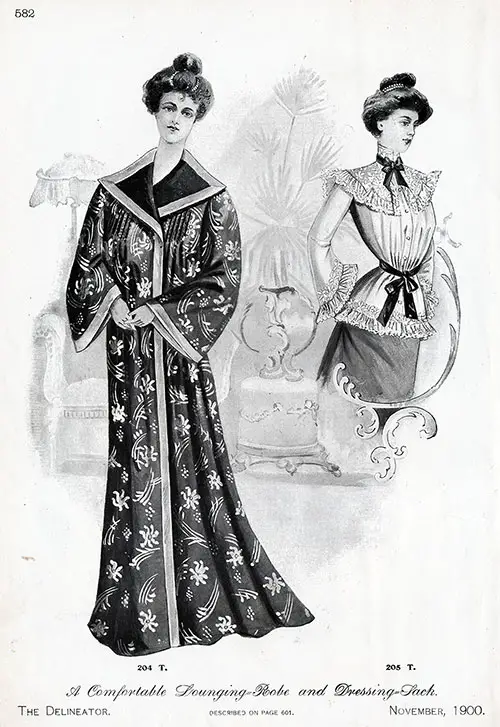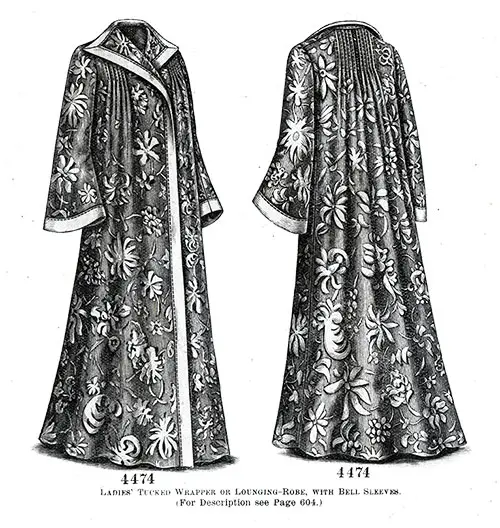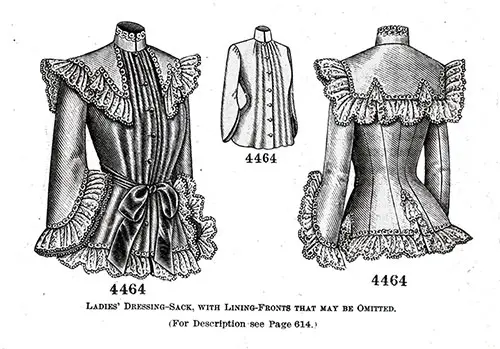Ladies Lounging Robe and Dressing Sack November 1900

Ladies' Lounging-Robe No. 204 T
The natural and graceful adjustment of the Kimono styles is apparent in this simply constructed wrapper. Its development included Dark-blue silk, flowered in white, combined with light and dark silk.
The fronts and back are tucked for a short distance at the top, and the extended narrow doubled collar is extended down the fronts in trimming-band fashion.
The robe laps widely, and at the top, the fronts are turned back in triangular revers. The comfortable one-seam sleeves are in loose, flowing style at the bottom, where they are completed with bands to correspond with these on the fronts.
Dressmaker Options
Japanese silk, French flannel, cashmere, wailing, albatross, etc., may be used in the reproduction of the mode. Use the material in any contrasting shade for the collar and bands.
Patten Information
The pattern, which is No. 4474 and costs 1s. or 25 cents, is in seven sizes for ladies from thirty to forty-two inches, bust measure. View this pattern again on page 596.
Ladies' Ticked Wrapper or Lounging-Robe No. 4474

No. 4474 Ladies' Ticked Wrapper or Lounging-Robe, with Bell Sleeves. (For Description see Page 604.)
This wrapper is illustrated on page 596, and in figure No. 204 T in this number of The Delineator.
Description
The style is fashioned somewhat on Kimono lines, and in this instance is shown developed in heliotrope French flannel having a sizeable flowered design in pale yellow in combination with plain flannel matching the flowers.
The back has fullness at the top taken up in a group of tucks that are stitched for a short distance below which they fall free. The fronts are tucked similarly, and the doubled collar finishing the neck is continued down the front edges of the garment in a band fashion.
At the top, the fronts are turned back in revers and below are lapped broadly. The comfortable one-seam sleeves are in bell style slightly gathered at the top and lengthened by a band similar to the one finishing the fronts.
Dressmaker Options
Blue cashmere, Henrietta or vailing will reproduce the robe attractively in combination with ribbon or silk. For wear in warm climates, dimity, cambric, challis, and soft China or India silks will be found satisfactory.
The garment will be found so comfortable and convenient, and the construction so simple, that no wardrobe should be without one. There are so many, inexpensive cotton and woolen goods suited to the mode that expense need hardly be considered.
Pattern Information
We have pattern No. 4474 in seven sizes for ladies from thirty to forty-two inches, bust measure.
To make the wrapper for a lady of medium size will need seven yards and three-fourths of fabric twenty-seven inches wide, with a yard and seven-eighths of material twenty or more inches wide for the collar and bands.
Price of pattern, Is. or 25 cents.
Ladies' Dressing Sack No. 205 T

White silk and all-over lace are here united in the dainty dressing-sack, the decoration consisting of ribbon, lace edging, and appliqué matching the all-over lace. However, you can omit the full fronts made over fitted linings, if desired.
At the back and sides, the adjustment is smooth, the center and under-arm seams ending a short distance below the waist, and the back edges of the fronts are rounded away at the bottom.
A fanciful sailor-collar arranged to reveal the full fronts is an exciting feature, and a standing collar is at the neck. The two-seam sleeves are shaped to display the arm prettily, and the sack closes at the center, ribbon-ties drawing the fullness in at the waist.
Dressmaker Options
Blue cashmere and white silk will combine harmoniously.
Pattern Information
The pattern, which is No 4464 and costs 9d. or 20 cents, is in eight sizes for ladies from thirty to forty-four inches, bust measure, and is also illustrated on page 608.
Ladies’ Dressing-Sack No. 4464

No. 4464 Ladies’ Dressing-Sack, with optional Lining-Fronts.
Description on Page 614 | Illustrated on Pages 582 and 608
Description
You can view this attractive sack on page 608, and in figure No. 205 T in this magazine.
A fanciful sailor-collar is a conspicuous feature of the design, which is shown developed in pink cashmere and decorated with insertion and edging.
The full fronts are mounted on short, fitted linings that may, however, be omitted; they are gathered at the neck, the fulness being held in at the waist by ribbon ties, or allowed to fall free to the lower edge.
The back and sides are fitted smoothly, and the closing is made at the center of the front with buttons and button-holes.
The sailor collar is notched and is wide apart to display the fullness in the fronts, and the under-arm and center seams end a short distance below the waist, the back edges of the fronts being rounded away gracefully.
A standing collar is at the neck, and the sleeves are in loose two-seam style, deeply rounded at the bottom.
Dressmaker Options
A pretty and inexpensive dressing-sack could be produced in pale-blue figured delaine with insertion and knife-plaitings of net material for the decoration.
Pattern Information
We have pattern No. 4464 in eight sizes for ladies from thirty to forty-four inches, bust measure.
For a lady of medium size, the dressing-sack needs two yards and seven- eighths of fabric thirty-six inches wide.
Price of pattern, 9d. or 20 cents.
Terminology
Dressing Sack - a woman's loose jacket worn while dressing or lounging
“Descriptions of Figures in Colors, Tints, Etc., Shown on First Page of Cover and Pages 571 to 591 Inclusive,” in The Delineator: An Illustrated Magazine of Literature and Fashion, Paris-London-New York-Toronto: The Butterick Publishing Co. Ltd., Vol. LXI, No. 5, November 1900, p. 582, 596, 601, 604-605, 608, 614.
Note: We have edited this text to correct grammatical errors and improve word choice to clarify the article for today’s readers. Changes made are typically minor, and we often left passive text “as is.” Those who need to quote the article directly should verify any changes by reviewing the original material.
Vintage Loungewear Fashions
GG Archives
Vintage Loungewear Fashions
- Ladies Effective Indoor Outfits 196 T & 197 T - 1900
- Ladies Fancy House Gowns 206 T & 207 T - 1900
- Ladies' Morning Dress and Blouse 156 T & 157 T - 1900
- Ladies Lounging Robe and Dressing Sack 204 T & 205 T - 1900
- Gowns and Negligees for House Wear 1901
Vintage Fashion Topics
Updates and Social Media
- Visit our GG Archives Vintage Fashions Facebook Page for the Latest News About the Activities of the Archives.
